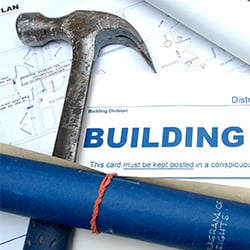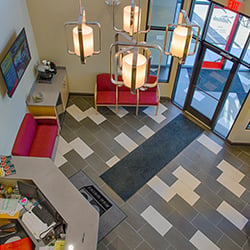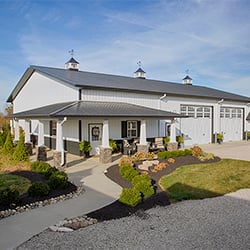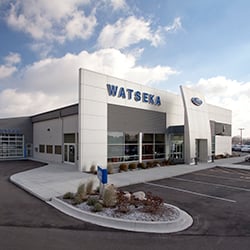Posts | Building Tips | Cost
How Much Does a Pole Barn Cost in 2025? 5 Factors to Know
Angie joined FBi Buildings in 2012 and is now the Director of Marketing. She's an avid reader and enjoys outdoor leisure and cheering on her two daughters at their sporting events.
Here at FBi Buildings, we have a daily influx of customers calling or sending messages via webchat asking, “How much does a pole barn cost?” This is a great question, but, unfortunately, there is no black and white answer. It's been over one year since COVID-19 became a global pandemic, and the reduced labor forces are still being felt. We all know that when you have supply issues, demand issues also start to rise.
Unfortunately, for the construction industry, this means that commodity prices have been on the rise. Steel and lumber prices keep going up. Your building features (think doors, windows, cupolas, etc) have longer lead times than normal. All of these challenges will certainly affect pole barn prices, and we will do our best to help guide you through your building options.
Once you get past the basic building shell, multiple factors will still influence your pole barn cost.
In this article, we’ve compiled a list of common cost components that’ll help provide you with a realistic project total.
How Much Does a Pole Barn Cost in 2025?
A standard pole building shell can cost anywhere from $20 to $60 per square foot. Now, you’re probably asking yourself, “Why is there a big difference in price per square foot?” Here’s why...
The following factors will determine if your pole barn is leaning towards the low/high side of the cost spectrum:
- Total square feet
- Type of features (e.g., overhangs, windows, walk-in doors, steel liner packages, etc.)
- Current nature of the commodities market (the price of steel)
Remember, it’s not uncommon for the cost of materials to fluctuate. If you've received a quote from us in the past, there's a good chance that the quote is now outdated. Our prices are normally good for 30 days. Anything past that will need a new quote, especially if the commodity markets have gone up.
For example, if you're needing a 60 x 80 pole barn with one entry door and one sliding door you'd be around the $20 per square foot. If you took that same building and added a porch, two cupolas, an interior liner package, upgraded Perma-Columns, and a dozen windows, you would be closer to the $50 - $60 threshold.
5 Major Pole Barn Costs You Can Expect
1) Site Costs
The most underrated expense of the building process is site costs. Site preparation is the work done on your land before pole barn construction. This process allows you to discover and resolve any site complications before it’s too late. The following factors drive site costs:
- Location and elevation
- Type of granular fill
- Building pad size
- Amount of object removal
Naturally, some projects will require more site prep than others, affecting the cost. Below are the typical site costs for the following building types:
| Agricultural | $1,000 to $30,000 |
| Residential | $500 to $5,000 |
| Commercial | $1,000 to $50,000 |
| Equine | $500 to $20,000 |
*Please note that the information above are averages to help with your planning. Costs may vary by project size.
Proper site preparation will extend your building’s lifetime and reduce total construction costs. You can further lower costs by owning the machinery and performing your excavation.
Feeling overwhelmed? We created a simple guidebook that’ll provide you with helpful insights in preparing your building site.
2) Design and Permitting Costs
The design costs for your pole barn relies heavily on the type of structure you want to build. Ask yourself, do you want to build:
- A spacious storage building to house your farm equipment?
- A custom hobby shop to showcase your classic car collection?
- A new commercial building for your booming business?
- A deluxe stall barn or riding arena for your horses?
Other design considerations include pole barn size, external/internal features, and future preparation (e.g., pole barn additions, adding a loft for extra storage, or even finishing the interior of your pole barn with insulation and steel liner).
Once you’ve selected a post frame building design, you’ll need to obtain a permit to move forward with construction. Permitting costs are based on the following factors:
- Building Size (square footage)
- Building Segment (Agricultural, Residential, Commercial, or Equine)
- Jurisdiction (state or county)
The best way to find out how much you will owe in permitting costs is to contact your city hall or county courthouse. Here’s an idea as to what you can expect:
Agricultural: $0 to $2,000
Please check to see if your county exempts ag-related buildings from permits. You’ll still need one, but it is free of charge.
Residential: $50 to $1,000
Depending on the site location, some residential buildings will require a permit from the town rather than the county.
Commercial: $1,000 to $100,000
Some commercial projects are required to obtain a permit at the state level. Also, commercial permits tend to be more expensive because they ask for:
-
- Mechanical Electrical Plumbing plans (MEPs)
- Architectural drawings
- Civil site drawings
- State’s stamp of approval
Equine: $50 to $3,000
The wide range of permitting costs is based on the fact that horse barns can be viewed as agricultural, personal, or commercial-use buildings.
On the bright side, most design fees (minus commercial properties) are included in the total package and are considerably less.
3) Finishing Costs

As stated above, adding external and internal features will impact your total pole barn cost.
Depending on your professional builder’s scope of work, they may have the following external and internal work subcontracted out:- Cabinets
- Carpet
- Concrete
- Drywall
- Electrical
- Framing
- HVAC
- Overhead doors
- Masonry
- Plumbing
- Trim
At FBi Buildings, we recommend being your general contractor when finishing a post frame home. Here’s why...
This unique structure doesn’t contain studs. Therefore, you’ll need to install interior stud framing on the perimeter walls and ceiling. Then, you can install electrical, HVAC, plumbing, drywall, etc.
Finally, you can add cabinetry, fixtures, artwork, shelving, and more. Eventually, these features add up, especially if you have someone else perform the work.
Think you have what it takes? Download our General Contracting Guidebook to ensure a successful building project.
4) Furnishing, Landscaping & Signage Costs
When building a pole barn, you’ll want to make sure your budget allows for extras such as furnishing, landscaping, and signage costs. Typically, these after-construction additions tend to be out of sight, out of mind in the early stages of the building process. Yet, these finishing touches make your building unique and will add to the resale value (if you decide to sell).
Some owners will want minimal landscaping – just enough to complete the project site visually. Meanwhile, others will put a lot of effort into their landscaping. Don’t forget to get the best bang for your buck with energy-efficient landscaping plans.
As you think through paving – sidewalks and driveways – decide if they are nice-to-haves or need-to-haves.
Please keep in mind that some commercial projects require these features. Examples include landscaping, sidewalks, parking lots, signage for your business, etc.
Overall, these extra features will add value to your project.
5) Financing Costs
Ideally, you’d have the cash on hand to fully fund your dream pole barn. Right? Unfortunately, this isn’t always the case, and you’ll have to take out a loan.
Financing costs include principal and interest on any loans you may need to take out. Don’t forget to ask your post frame construction company the following questions:
- Do you have any special financing offers?
- Do you have a list of lenders I can contact?
A great builder will have these resources on hand to help you navigate the world of pole barn financing.
Pole Barn Cost Breakdown
Now, do you understand why we state ranges for pole barn costs? It truly comes down to the type and size of building you’re interested in purchasing.
After reviewing each cost component, a rough percentage breakdown of an average post frame building will be:
- Building Shell: 40% (20% for Commercial)
- A higher percentage for farm shops and cold storage buildings.
- Finishing: 25% (45% for Commercial)
- A higher percentage for commercial, retail, or office spaces, as well as finished suburban buildings.
- Concrete: 20% (15% for Commercial)
- A higher percentage for larger storage buildings, or if you want a thicker finish.
- Site Prep: 14% (15% for Commercial)
- This percentage depends on your building size and site condition.
- Permit: 1% (5% for Commercial)
- This percentage depends on the type of building. The percentage is higher for commercial projects.
It’s important to note that the above percentages will vary based on a variety of factors. For instance: in-floor heating within the concrete, special overhead doors, unique building features, and extensive site preparation. If you don’t plan to finish out your building, the interior portion of the finishing percentage will be significantly reduced.
Regardless, it’s a great starting point for your budget.
Do all Size Pole Barns Cost the Same?
This is a great question and one that needs to be addressed. It is assumed that smaller post frame buildings cost less than larger buildings. Do you remember what we discussed earlier?
A standard pole building shell can cost anywhere from $20 to $55 per square foot. Now, you’re probably asking yourself, “Why is there a big difference in price per square foot?” Here’s why...
The following factors will determine if your pole barn is leaning towards the low/high side of the cost spectrum:
- Total square feet
- Type of features (e.g., overhangs, windows, walk-in doors, steel liner packages, etc.)
- Current nature of the commodities market (the price of steel)
To help you better understand where the price break comes from, here's a cheat sheet to help you get started.
- If your overall square footage is 1,199 or less your price per square foot would be $45 - $60.
- If your overall square footage is 1,200 to 2,500 your price per square foot would be $35 - $50.
- If your overall square footage is 2,501 to 4,000 your price per square foot would be $30 - $40.
- If your overall square footage is 4,001 to 8,000 your price per square foot would be $20 - $30.
- If your overall square footage is over 8,000 your price per square foot would be $15 - $25. Once you get to this square footage range, your price will highly depend on your building features.
Please keep in mind that these are ranges based on current commodity market prices. These are not permanent prices and will fluctuate with the markets.
Remember, cheaper isn’t always better.
Although the initial cost may seem intimidating, it doesn’t mean that you should purchase a pole barn kit at the nearest hardware store. Our first instinct is to compare prices and go with the cheapest option. From peanut butter and laundry detergent to electronics and vehicles, we’re all guilty of this practice. Save your thriftiness for another time.
As the old saying goes, “you get what you pay for.” At first, a cheap building sounds great! Realistically speaking, it’s a lower-quality product that will require more follow-up maintenance. In the long run, cheap construction will cost your bank account more.
Besides, a post frame structure is an investment. The more time and money you invest in a project, the more value it will add — just food for thought.
Are You Ready to Build Your Pole Barn?
If you’re still following along, you can see there are multiple factors that will influence your total project cost. No black and white number works for everyone. Ultimately, the price comes down to how you design your pole barn.
Ready to take the next step in the building process? Please give us a call at (800) 552-2981 or reach us online to determine your pole barn estimate.
Are you unsure if your idea is worth pursuing? That’s okay! You can still request a rough ballpark quote without 100% committing to a post frame project.
Do you have more questions that are not covered in this article? If you need help designing and planning, please contact FBi Buildings at 800.552.2981 or click here to email us. If you are ready to get a price, click here to request a quote and a member of our customer engagement team will help you determine the next steps of your project.




